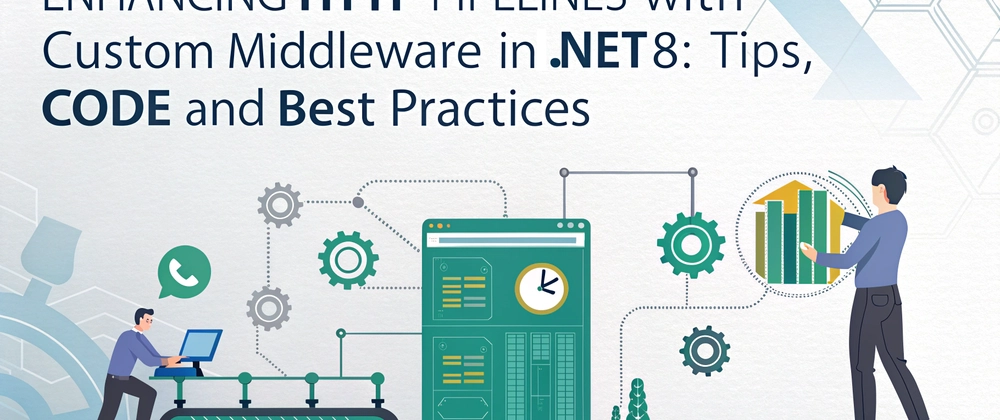In this post, we'll explore how to create custom middleware in .NET 8 that can optimize and enhance your HTTP request pipeline. Custom middleware offers a powerful way to inject custom logic into every request and response, allowing you to implement logging, security, performance enhancements, and much more.
Table of Contents
- Introduction
- What is Middleware in .NET?
- Creating Custom Middleware in .NET 8
- Code Example: Custom Header Middleware
- Best Practices for Developing Middleware
- Usage Scenarios and Tips
- Conclusion
Introduction
Middleware in ASP.NET Core is a critical component of the request processing pipeline. By constructing a sequence of middleware, developers can handle, modify, or even terminate HTTP requests according to custom logic. With .NET 8, creating and integrating custom middleware has become more straightforward, allowing you to tailor your application's behavior to the specific needs of your project.
In this article, we’ll cover:
- The fundamentals of middleware in .NET.
- How to build custom middleware.
- Real-world code examples.
- Best practices for middleware design and usage.
What is Middleware in .NET?
Middleware is software that sits between the incoming HTTP request and the execution of your application logic. It acts as a filter, performing tasks such as:
- Logging or monitoring requests.
- Implementing authentication and authorization.
- Modifying request or response objects.
- Handling errors and exceptions globally.
In ASP.NET Core, every component in the request pipeline is built as middleware. Each middleware component is responsible for invoking the next middleware in the pipeline or short-circuiting the pipeline based on custom conditions.
Creating Custom Middleware in .NET 8
Creating custom middleware in .NET 8 involves creating a class that encapsulates your desired logic and then integrating that middleware into the HTTP request pipeline. The key steps include:
- Defining a class that accepts a
RequestDelegate. - Implementing an asynchronous invocation method (often named
InvokeAsync). - Injecting your middleware using the built-in
UseMiddlewareextension method.
Let's put these steps into practice with a sample middleware that adds a custom header to every HTTP response.
Code Example: Custom Header Middleware
Below is the code for a simple custom middleware that injects an X-Custom-Header with a specific value into every response:
using System.Threading.Tasks;
using Microsoft.AspNetCore.Http;
public class CustomHeaderMiddleware
{
private readonly RequestDelegate _next;
public CustomHeaderMiddleware(RequestDelegate next)
{
_next = next;
}
public async Task InvokeAsync(HttpContext context)
{
// Before invoking the next middleware, you can inspect or modify the request.
// For example, add a custom header to the response.
context.Response.OnStarting(() => {
context.Response.Headers.Add("X-Custom-Header", "MiddlewareExample");
return Task.CompletedTask;
});
// Call the next middleware in the pipeline.
await _next(context);
}
}
Integrating the Middleware
To integrate the custom middleware, use the UseMiddleware<T>() extension method in your Program.cs or Startup.cs file:
var builder = WebApplication.CreateBuilder(args);
var app = builder.Build();
// Register the custom middleware
app.UseMiddleware<CustomHeaderMiddleware>();
app.MapGet("/", () => "Hello from .NET 8 with Custom Middleware!");
app.Run();
In this example, every HTTP response generated by your application will include the X-Custom-Header header with its configured value.
Best Practices for Developing Middleware
When developing custom middleware in .NET 8, consider the following best practices:
- Keep It Focused: Design middleware to perform a single responsibility rather than consolidating multiple concerns. This simplifies debugging and future enhancements.
- Leverage Dependency Injection (DI): If your middleware requires additional services, use constructor injection to access them seamlessly.
-
Asynchronous Programming: Always use asynchronous programming patterns (
async/await) to ensure that your middleware scales well under load. - Error Handling: Integrate with global exception handling middleware or include robust error handling within your middleware to prevent unhandled exceptions.
- Short-Circuiting When Necessary: If the middleware logic determines that the request should not proceed further (e.g., unauthorized access), use short-circuiting to return an appropriate response immediately.
Usage Scenarios and Tips
Custom middleware can be applied in many scenarios:
- Logging and Monitoring: Record request details for auditing or performance analysis.
- Security Enhancements: Implement rate limiting, IP filtering, or add custom security headers.
- Performance Optimizations: Cache results or bypass expensive computations for static content.
- Content Transformation: Modify request payloads or response bodies before further processing.
Remember to order your middleware appropriately in the pipeline, as the sequence can influence how requests and responses are processed.
Conclusion
Custom middleware in .NET 8 opens up a realm of possibilities to enhance the HTTP request pipeline with your specialized logic. By following the best practices and coding patterns discussed in this guide, you can build robust, maintainable, and scalable middleware to address various challenges in your application.
I hope this post helps you understand how to create and use custom middleware effectively. Feel free to share your thoughts, ask questions, or provide feedback in the comments below!
Happy coding!



Top comments (0)